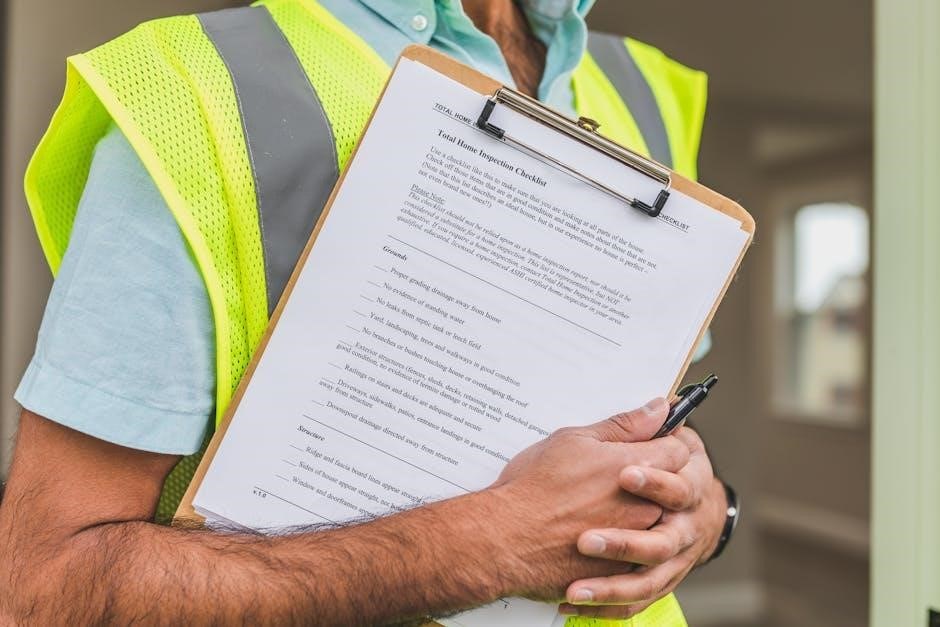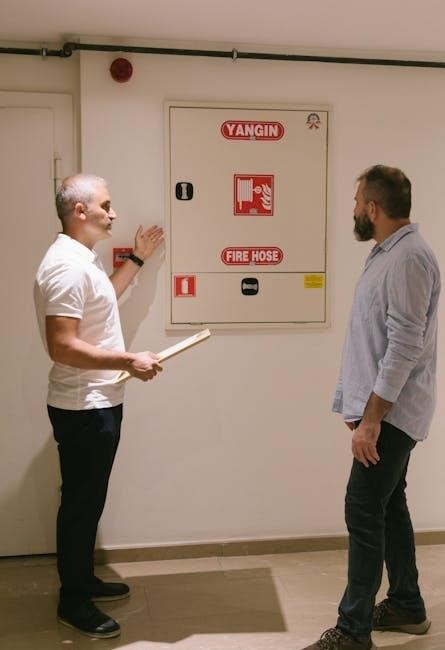Fire doors are critical components in building safety, preventing the spread of fire and smoke. Regular inspections ensure compliance with regulations like NFPA 80 and 101, maintaining their integrity and functionality to protect lives and property.
1.1 Importance of Fire Doors in Building Safety
Fire doors play a crucial role in building safety by acting as barriers to slow the spread of fire, smoke, and toxic gases. They protect escape routes, prevent fire from spreading between compartments, and ensure the safety of occupants. Properly functioning fire doors are essential for maintaining structural integrity during fires, allowing people to evacuate safely and enabling firefighters to control the blaze effectively. Their importance cannot be overstated, as they directly contribute to saving lives and reducing property damage.
Fire doors are a critical component of a building’s passive fire protection system, ensuring compliance with safety regulations and standards. They must be inspected regularly to maintain their effectiveness, as any failure can compromise the entire fire safety strategy. Regular inspections ensure fire doors remain reliable and functional, safeguarding lives and property in emergencies.
1.2 Legal Requirements for Fire Door Inspections
Fire door inspections are mandated by law to ensure compliance with safety standards. Regulations like NFPA 80 and 101 require regular inspections to verify fire doors’ functionality. The Responsible Person must ensure inspections are conducted by certified professionals, with records maintained for compliance. Local fire codes may also impose additional requirements. Failure to comply can result in legal penalties, highlighting the importance of adhering to these standards to safeguard lives and property.

Regulatory Standards for Fire Door Inspections
Regulatory standards like NFPA 80 and NFPA 101 outline requirements for fire door inspections, ensuring doors meet safety criteria to prevent fire spread and protect occupants.
2.1 Overview of NFPA 80 Standards
NFPA 80 provides comprehensive guidelines for fire doors, outlining inspection frequencies, hardware requirements, and testing methods. It ensures doors are installed, maintained, and function properly to contain fires. The standard covers components like labels, frames, and seals, emphasizing compliance to safeguard lives and property. Regular adherence to NFPA 80 is crucial for maintaining fire safety standards in buildings.
2.2 NFPA 101 Standards for Fire Door Compliance
NFPA 101, the Life Safety Code, outlines requirements for fire door compliance, focusing on occupant safety and emergency egress. It mandates proper signage, functionality of door closers, and clear escape routes. Fire doors must be labeled, with hardware meeting specific standards. NFPA 101 ensures doors are part of a comprehensive life safety plan, integrating with other fire protection systems to safeguard building occupants during emergencies, while complementing NFPA 80’s technical requirements.
2.3 Local Fire Safety Regulations and Codes
Local fire safety regulations often mandate additional requirements for fire door inspections beyond national standards. These codes may specify mandatory inspection frequencies, detailed signage requirements, and particular hardware standards. Local authorities may also require documentation to be submitted for compliance verification. Fire doors must meet both national and local codes to ensure safety and avoid penalties. Always consult local fire safety codes to supplement NFPA guidelines and ensure comprehensive compliance in your jurisdiction.

Components of a Fire Door Inspection Checklist
- Fire Door Label and Certification: Verify the door’s fire rating and certification label.
- Door Leaf and Frame Condition: Check for damage or wear on the door and frame.
- Hardware and Ironmongery: Ensure hinges, handles, and closers are functional and secure.
- Gaps and Seals: Measure gaps and inspect smoke and intumescent seals for integrity.
- Fire Door Signage: Confirm proper signage is visible and legible.
These components ensure the door’s effectiveness in fire scenarios and compliance with safety standards.
3.1 Fire Door Label and Certification
A fire door’s label and certification are crucial for verifying its fire-resistance rating and compliance with safety standards. During inspections, check for a visible label, plug, or marking on the door, typically on the top or side, indicating its certification. Ensure all hardware, such as hinges and closers, carries the CE mark, confirming compatibility and safety. Missing or damaged labels may render the door non-compliant, potentially compromising fire safety. Always follow the instructions provided with the certification for proper functionality and regulatory adherence.
3.2 Door Leaf and Frame Condition
The door leaf and frame must be inspected for damage, warping, or rotting, which can compromise fire resistance. Check for cracks, dents, or misalignment affecting proper closure. Ensure the frame is secure and free from decay, especially around hinges and edges. Verify that all components, including bolts and screws, are tightly fastened. Any damage to the door leaf or frame can weaken its structural integrity, potentially allowing fire and smoke to penetrate. Address any issues promptly to maintain safety and compliance.
3.3 Hardware and Ironmongery (Hinges, Handles, Closers)
Inspect all hardware and ironmongery, including hinges, handles, and door closers, for proper function and condition. Ensure hinges are securely attached to both the door and frame, with no signs of damage or loosening. Handles must operate smoothly, allowing easy opening and closing. Door closers should function correctly, ensuring the door shuts and latches without assistance. Check for CE markings on all components, confirming compatibility with the fire door’s rating. Address any wear, damage, or malfunctions promptly to maintain safety and compliance.
3.4 Gaps and Seals (Smoke and Intumescent Seals)
Inspect the gaps between the fire door and frame, ensuring they are within the recommended tolerance (typically 2-4mm). Check smoke and intumescent seals for integrity, verifying no signs of damage, wear, or compression. Ensure seals are correctly fitted and free from obstructions. Proper gaps and functional seals are critical to prevent fire and smoke spread. Any defects must be documented and repaired promptly to maintain the door’s fire-resistance rating and ensure compliance with safety standards.
3.5 Fire Door Signage and Visibility
Ensure all fire doors are clearly marked with appropriate signage, such as “Fire Door” or similar markings, to enhance visibility and identification. Verify that signs are legible, properly displayed, and comply with local regulations. Check that doors are not obscured by obstructions or paint, ensuring they remain visible and accessible. Proper signage and visibility are crucial for emergency response and compliance with fire safety standards, ensuring quick identification and use of fire doors during emergencies.

Performing a Fire Door Inspection
Conduct inspections systematically, verifying door labels, hardware functionality, and seals. Ensure compliance with NFPA standards and document findings using a detailed checklist for accuracy and compliance.
4.1 Pre-Inspection Preparation
Before starting a fire door inspection, gather necessary tools and review the checklist. Familiarize yourself with local regulations and NFPA standards. Ensure access to all doors and schedule inspections during low-traffic times. Verify that all safety protocols are in place to avoid disruptions. Prepare documentation for recording findings, including a fire door inspection form, and ensure all team members are trained on the process. This preparation ensures efficiency and accuracy during the inspection.
4.2 Step-by-Step Inspection Process
Begin by verifying the fire door label and certification. Check the condition of the door leaf and frame for damage or wear. Inspect hinges, handles, and closers for proper function and CE marking. Measure gaps between the door and frame, ensuring they are within 2-4mm. Examine smoke and intumescent seals for integrity. Ensure clear visibility of fire door signage. Test the door closer to confirm it shuts securely. Document all findings, noting any defects or necessary repairs for corrective action.
4.3 Tools and Equipment Needed
A comprehensive fire door inspection requires specific tools. A detailed checklist, such as a PDF or printable version, ensures all components are evaluated; A measuring tool, like a ruler or caliper, is essential for checking door gaps and clearances. A flashlight can help inspect hidden or hard-to-reach areas. Additionally, a camera may be useful for documenting defects. Ensure access to regulatory guidelines, such as NFPA 80, for reference. Proper tools guarantee a thorough and accurate inspection process, ensuring compliance and safety standards are met effectively.

Documenting Inspection Results
Accurate documentation is crucial for tracking fire door inspections. Use a detailed inspection form to record findings, noting defects and required repairs. Maintain organized records for compliance and future reference.
5.1 Completing the Fire Door Inspection Form
A fire door inspection form is essential for documenting the condition and compliance of each fire door. The form should include sections for the door’s location, type, and fire rating. Checkboxes or spaces for noting the condition of the door leaf, frame, hardware, and seals are standard. Defects, such as damaged labels or excessive gaps, should be recorded in detail. The responsible person must sign and date the form, ensuring accountability. Proper completion guarantees clarity and traceability of repairs. Always reference NFPA 80 standards for compliance.
5.2 Recording Defects and Necessary Repairs
Accurately documenting defects and required repairs is crucial for ensuring fire door functionality. Record the location, type, and severity of issues, such as damaged labels, excessive gaps, or faulty hardware. Note the urgency of repairs to prioritize actions. Use the inspection form to describe defects in detail and outline corrective measures. This ensures transparency and accountability, helping to maintain compliance with fire safety standards like NFPA 80. Proper documentation also aids in tracking repairs and verifying completion, ensuring doors remain safe and functional.
5.3 Maintaining Inspection Records
Maintaining detailed and organized inspection records is essential for compliance and accountability. Store completed checklists, defect reports, and repair documentation securely, both physically and digitally. Regularly review records to ensure all issues are resolved and doors remain compliant. This documentation serves as proof of adherence to fire safety standards like NFPA 80 and supports audits or inspections by authorities. Organized records also provide a historical view of door maintenance, aiding in future inspections and ensuring continuous safety.

Common Issues Identified During Inspections
Damaged or missing fire door labels, excessive gaps between doors and frames, and malfunctioning hardware are frequent issues found during inspections, compromising fire safety and compliance.
6.1 Damaged or Missing Fire Door Labels
Damaged or missing fire door labels are a common issue during inspections. These labels are essential as they indicate the door’s certification and fire resistance rating. A missing or illegible label can lead to non-compliance with safety standards, potentially resulting in fines or serious safety risks. It is crucial to ensure all fire doors have intact, legible labels to verify their fire rating and certification status, ensuring they function as intended during emergencies.
6.2 Excessive Gaps Between Door and Frame
Excessive gaps between the fire door and its frame can compromise fire safety by allowing smoke and flames to pass through. Properly maintained gaps should be between 2mm and 4mm, as specified in standards like NFPA 80. Larger gaps can undermine the door’s fire resistance, making it ineffective during a fire. Regular inspections should check for these gaps and ensure they are within acceptable limits to maintain the door’s functionality and safety compliance.
6.3 Malfunctioning Door Closers and Hinges
Malfunctioning door closers and hinges are common issues detected during inspections. Door closers must ensure the door automatically closes and latches properly to maintain fire resistance. Hinges should be secure, with no signs of damage or excessive wear. If these components fail, the door may not close correctly, compromising its fire-rated performance. Inspectors should check for proper CE markings on hardware and ensure all parts function as intended. Any defects must be repaired or replaced promptly to maintain safety and compliance with fire standards.

Maintenance and Repair of Fire Doors
Regular maintenance ensures fire doors remain functional and compliant. Inspections identify defects early, preventing major repairs. Addressing issues promptly maintains safety and meets regulatory standards.
7.1 Scheduling Routine Maintenance
Regular maintenance is essential to ensure fire doors function properly. Schedule inspections monthly and annually, focusing on door labels, gaps, and hardware. Address minor issues promptly to prevent major repairs. Use a fire door inspection checklist to track findings and ensure compliance with NFPA standards. Maintain detailed records of inspections and repairs for auditing purposes. Consistent upkeep ensures fire doors remain reliable, safeguarding lives and property during emergencies.
7.2 Repairing vs. Replacing Damaged Components

When inspecting fire doors, assess whether damaged components can be repaired or require replacement. Minor issues like loose hinges may be fixed, while significant damage to labels or seals necessitates replacement. Ensure all repairs comply with NFPA standards and involve certified professionals. Use the fire door inspection checklist to document defects and determine the appropriate action. Promptly addressing damaged parts maintains fire safety and prevents potential failures during emergencies, ensuring compliance and reliability.
7.3 Ensuring Compliance After Repairs
After repairs, ensure fire doors meet all regulatory standards by reinspecting the assembly. Verify that repaired or replaced components comply with NFPA 80 and NFPA 101. Check functionality, labels, and seals. Use the fire door inspection checklist to confirm compliance. Document all repairs and inspections for records. Proper documentation ensures accountability and demonstrates adherence to safety regulations, maintaining the door’s integrity and reliability in emergencies.

Tools and Resources for Fire Door Inspections
Easily access printable checklists, digital inspection apps, and regulatory guidelines to streamline the inspection process. These tools ensure compliance and help maintain fire door functionality effectively.
8.1 Printable Fire Door Inspection Checklists
Printable fire door inspection checklists are essential tools for ensuring compliance with safety standards. These checklists, often available as PDFs, provide a structured framework to evaluate fire door components, such as labels, hardware, gaps, and seals. They allow inspectors to document defects, track repairs, and maintain records for regulatory compliance. Many checklists align with standards like NFPA 80 and 101, ensuring thorough inspections. Downloadable templates simplify the process, making it easier to identify and address issues promptly, thereby enhancing fire safety and protecting occupants.
8.2 Digital Inspection Software and Apps
Digital inspection software and apps streamline fire door inspections, offering real-time tracking and reporting. These tools provide digital checklists, photo documentation, and cloud storage for records. Apps like those mentioned in NFPA 80 guidelines enable inspectors to quickly identify issues, assign repairs, and generate compliance reports. They eliminate paper-based errors and save time, ensuring accurate and efficient inspections. Many platforms also offer customizable templates, making it easy to adapt to specific regulatory requirements and maintain thorough documentation for audits and compliance purposes.
8.3 Links to Regulatory Guidelines and PDF Resources
Accessing regulatory guidelines and PDF resources is essential for ensuring compliance with fire door standards. Official websites like NFPA.org offer downloadable PDFs of NFPA 80 and NFPA 101 standards, providing detailed checklists and inspection criteria. Additionally, platforms like Safelincs and Zen Trades offer free fire door inspection checklists in PDF format. These resources include comprehensive inspection forms, defect recording templates, and best practices for maintaining fire door integrity. They are invaluable tools for inspectors and facility managers aiming to meet legal and safety requirements efficiently;

Best Practices for Fire Door Compliance
Adhere to NFPA standards, train staff on fire door safety, and conduct regular inspections. Ensure doors are always closed and functional, with clear signage and proper hardware maintenance.
9.1 Training Staff on Fire Door Safety
Training staff on fire door safety is essential for ensuring compliance and safety. Educate employees on proper inspection techniques, emphasizing the importance of closed doors and functional hardware. Provide resources like checklists and guides to help them identify issues. Regular training sessions can enhance awareness and ensure that fire doors remain effective in preventing fire spread and protecting lives during emergencies.
9.2 Regular Inspection Frequency
Regular fire door inspections are vital to ensure compliance and safety. Inspections should occur at least annually by certified professionals, with monthly checks by staff for functionality. High-traffic areas may require more frequent inspections. Use a fire door inspection checklist PDF to document findings, ensuring all components are assessed. Proper documentation helps maintain compliance with standards like NFPA 80 and 101, while addressing issues promptly prevents safety risks.
9.4 Collaboration with Certified Inspectors
Collaborating with certified inspectors ensures fire door inspections meet regulatory standards. Their expertise guarantees thorough evaluations using fire door inspection checklists, ensuring compliance with NFPA 80 and 101. Certified professionals identify potential issues, such as damaged labels or excessive gaps, and provide actionable solutions. Regular collaboration maintains safety and legal compliance, while their documentation supports audit requirements. This partnership is essential for upholding fire safety and protecting lives and property effectively.
Fire door inspections are vital for ensuring safety and compliance, protecting lives and property. Regular checks, guided by checklists, help maintain integrity and prevent fire spread effectively.
10.1 The Role of Fire Door Inspections in Saving Lives
Fire door inspections play a crucial role in saving lives by ensuring doors function properly during emergencies. They prevent fire and smoke spread, protecting occupants. Regular checks identify defects, enabling timely repairs. Compliance with standards like NFPA 80 ensures doors maintain their fire-resistance ratings. A well-maintained fire door acts as a barrier, buying time for evacuation and reducing risks. Proper inspection and maintenance are essential for safeguarding lives and property effectively.
10.2 Final Thoughts on Compliance and Safety
Adhering to fire door inspection standards is paramount for ensuring safety and compliance. Proper inspections and maintenance prevent fire spread, protecting lives and property. Non-compliance risks legal penalties and compromises safety. Regular checks by certified inspectors guarantee doors function as intended. Safety is a shared responsibility, requiring attention to detail and commitment to regulations. By prioritizing fire door compliance, buildings can ensure occupant safety and avoid potential hazards effectively.
